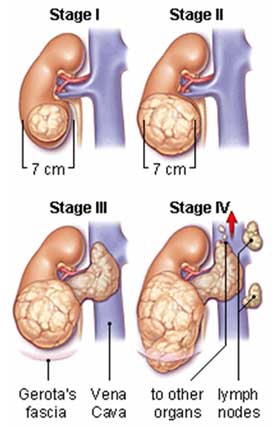Wilms Tumor Staging
After making a diagnosis of Wilms tumor, doctors need to assess how advanced the tumor is, including how large it is, how far it has spread, and whether it has invaded other tissues. This is called “staging” the tumor. Staging allows the cancer care team to Identify the best treatment approach using a combination of chemotherapy, surgery and radiation therapy. It will also provide information about the outlook for cure.
The staging system used to describe the extent of spread of Wilms tumors was developed by the National Wilms Tumor Study Group (NWTS). The NWTS system describes Wilms tumor stages using Roman numerals I through V (1 to 5).
Stage I
-
The tumor is only in the kidney, and was removed completely by surgery. The cancer has not grown into blood vessels next to the kidney. The tissue layer (the capsule) that surrounds the cancer was not broken during surgery.
-
About 40% of all Wilms tumors are stage I.
Stage II
The cancer grew beyond the kidney, but was completely removed surgically without any apparent cancer left behind. One or more of the following features may be present:
-
The cancer extended beyond the kidney into nearby fatty tissue, but was removed completely.
-
Cancer extended into blood vessels near the kidney but was removed.
-
Cancer "spilled" into the area next to the kidney during surgery.
-
About 20% of all Wilms tumors are stage II.
Stage III
This stage refers to Wilms tumors that have not been completely removed. The cancer remaining after surgery is limited to the abdomen. One or more of the following features may be present:
-
Cancer has spread to lymph nodes in the abdomen or pelvis, but not to more distant lymph nodes, such as those within the chest.
-
Cancer cells are present at the edge of the tissue removed by surgery, indicating that some of the cancer still remains after surgery.
-
Cancer "spilled" into the abdominal cavity before or during surgery, and is not limited to the area next to the kidney.
-
The cancer invaded nearby vital structures, and the surgeon could not remove it completely.
-
Deposits of tumor (tumor implants) are found along the lining of the abdominal cavity About 20% of all Wilms tumors are stage III.
Stage IV The cancer has spread through the bloodstream to other organs far away from the kidneys, such as the lungs, liver, or bone, or to lymph nodes.
-
About 10% of all Wilms tumors are stage IV.
Stage V
-
Tumors are in both kidneys at the time of diagnosis.
-
About 5% of all Wilms tumors are stage V.Most of the time Stage V tumors are tumors that have developed from primitive, abnormal tissue on both kidneys and do not represent spread from one kidney to the other.. The treatment is based on the kidney with the more advanced stage after surgery.
 courtesy: Google imagesmedsavailable.com
courtesy: Google imagesmedsavailable.comChildren's Oncology Group Germ Cell Tumor Staging System
After making a diagnosis of germ cell tumor, doctors need to assess how advanced the tumor is, based on the following criteria:
- The size of the tumor
- Whether the tumor has spread
- Whether it has affected lymph nodes and other tissues
This is called "staging" the tumor.
Because germ cell tumors can vary greatly, and can arise in different parts of the body, they can be difficult to stage. However, in the Children’s Oncology Group (COG), the following system has been useful in staging patients.
COG Germ Cell Tumor Staging System
- Stage I: The tumor has been entirely removed, and tumor markers are back to normal.
- Stage II: Microscopic traces of the tumor are still present after surgery; tumor markers do not return to normal.
- Stage III: Visible traces of tumor are left behind after initial treatment, and the lymph nodes are affected.
- Stage IV: The tumor has spread from its original site to other, more distant areas of the body.
